Larry Pileggi
FedECADO: A Dynamical System Model of Federated Learning
Oct 13, 2024Abstract:Federated learning harnesses the power of distributed optimization to train a unified machine learning model across separate clients. However, heterogeneous data distributions and computational workloads can lead to inconsistent updates and limit model performance. This work tackles these challenges by proposing FedECADO, a new algorithm inspired by a dynamical system representation of the federated learning process. FedECADO addresses non-IID data distribution through an aggregate sensitivity model that reflects the amount of data processed by each client. To tackle heterogeneous computing, we design a multi-rate integration method with adaptive step-size selections that synchronizes active client updates in continuous time. Compared to prominent techniques, including FedProx and FedNova, FedECADO achieves higher classification accuracies in numerous heterogeneous scenarios.
Towards Hyperparameter-Agnostic DNN Training via Dynamical System Insights
Oct 21, 2023Abstract:We present a stochastic first-order optimization method specialized for deep neural networks (DNNs), ECCO-DNN. This method models the optimization variable trajectory as a dynamical system and develops a discretization algorithm that adaptively selects step sizes based on the trajectory's shape. This provides two key insights: designing the dynamical system for fast continuous-time convergence and developing a time-stepping algorithm to adaptively select step sizes based on principles of numerical integration and neural network structure. The result is an optimizer with performance that is insensitive to hyperparameter variations and that achieves comparable performance to state-of-the-art optimizers including ADAM, SGD, RMSProp, and AdaGrad. We demonstrate this in training DNN models and datasets, including CIFAR-10 and CIFAR-100 using ECCO-DNN and find that ECCO-DNN's single hyperparameter can be changed by three orders of magnitude without affecting the trained models' accuracies. ECCO-DNN's insensitivity reduces the data and computation needed for hyperparameter tuning, making it advantageous for rapid prototyping and for applications with new datasets. To validate the efficacy of our proposed optimizer, we train an LSTM architecture on a household power consumption dataset with ECCO-DNN and achieve an optimal mean-square-error without tuning hyperparameters.
Power Grid Behavioral Patterns and Risks of Generalization in Applied Machine Learning
Apr 21, 2023Abstract:Recent years have seen a rich literature of data-driven approaches designed for power grid applications. However, insufficient consideration of domain knowledge can impose a high risk to the practicality of the methods. Specifically, ignoring the grid-specific spatiotemporal patterns (in load, generation, and topology, etc.) can lead to outputting infeasible, unrealizable, or completely meaningless predictions on new inputs. To address this concern, this paper investigates real-world operational data to provide insights into power grid behavioral patterns, including the time-varying topology, load, and generation, as well as the spatial differences (in peak hours, diverse styles) between individual loads and generations. Then based on these observations, we evaluate the generalization risks in some existing ML works causedby ignoring these grid-specific patterns in model design and training.
Towards Practical Physics-Informed ML Design and Evaluation for Power Grid
May 24, 2022

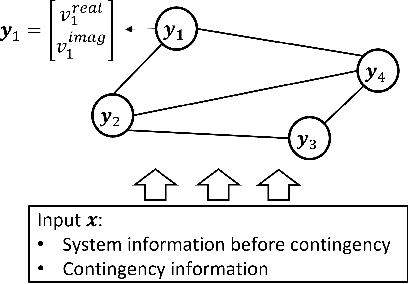
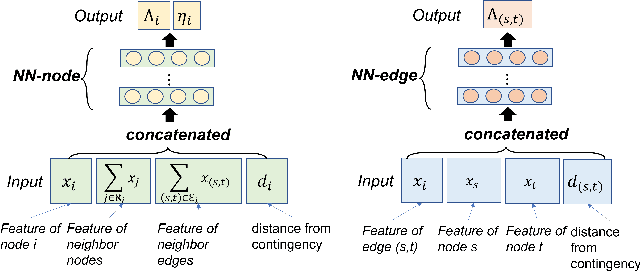
Abstract:When applied to a real-world safety critical system like the power grid, general machine learning methods suffer from expensive training, non-physical solutions, and limited interpretability. To address these challenges for power grids, many recent works have explored the inclusion of grid physics (i.e., domain expertise) into their method design, primarily through including system constraints and technical limits, reducing search space and defining meaningful features in latent space. Yet, there is no general methodology to evaluate the practicality of these approaches in power grid tasks, and limitations exist regarding scalability, generalization, interpretability, etc. This work formalizes a new concept of physical interpretability which assesses how a ML model makes predictions in a physically meaningful way and introduces an evaluation methodology that identifies a set of attributes that a practical method should satisfy. Inspired by the evaluation attributes, the paper further develops a novel contingency analysis warm starter for MadIoT cyberattack, based on a conditional Gaussian random field. This method serves as an instance of an ML model that can incorporate diverse domain knowledge and improve on these identified attributes. Experiments validate that the warm starter significantly boosts the efficiency of contingency analysis for MadIoT attack even with shallow NN architectures.
Adversarially Robust Learning for Security-Constrained Optimal Power Flow
Nov 12, 2021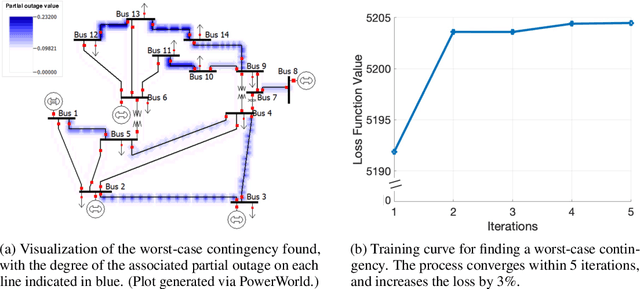

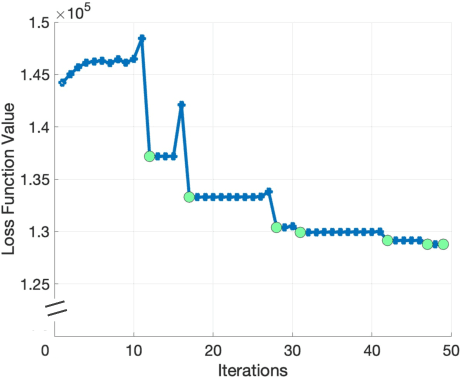
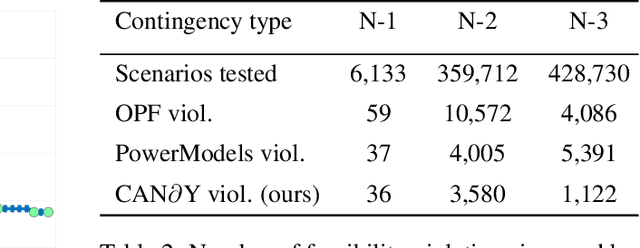
Abstract:In recent years, the ML community has seen surges of interest in both adversarially robust learning and implicit layers, but connections between these two areas have seldom been explored. In this work, we combine innovations from these areas to tackle the problem of N-k security-constrained optimal power flow (SCOPF). N-k SCOPF is a core problem for the operation of electrical grids, and aims to schedule power generation in a manner that is robust to potentially k simultaneous equipment outages. Inspired by methods in adversarially robust training, we frame N-k SCOPF as a minimax optimization problem - viewing power generation settings as adjustable parameters and equipment outages as (adversarial) attacks - and solve this problem via gradient-based techniques. The loss function of this minimax problem involves resolving implicit equations representing grid physics and operational decisions, which we differentiate through via the implicit function theorem. We demonstrate the efficacy of our framework in solving N-3 SCOPF, which has traditionally been considered as prohibitively expensive to solve given that the problem size depends combinatorially on the number of potential outages.
A Convex Method of Generalized State Estimation using Circuit-theoretic Node-breaker Model
Oct 07, 2021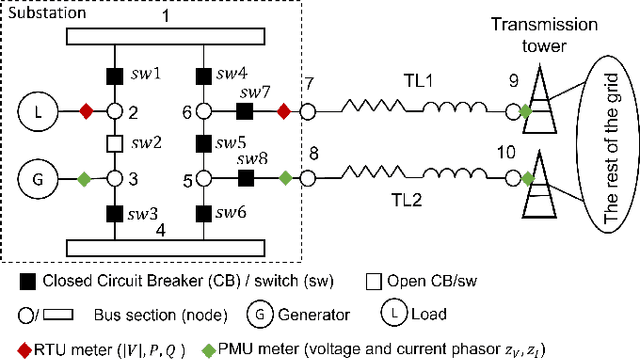
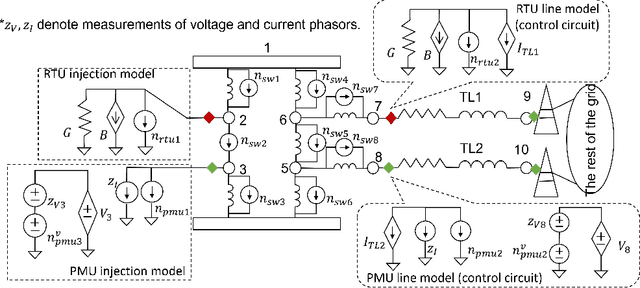
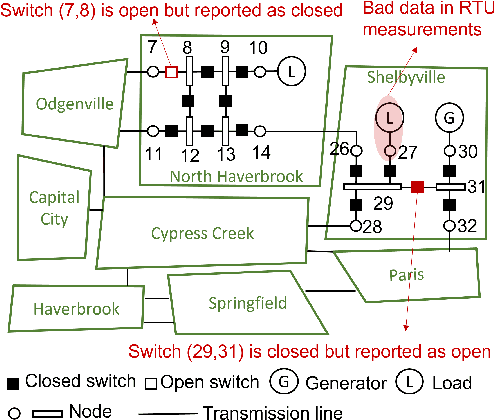
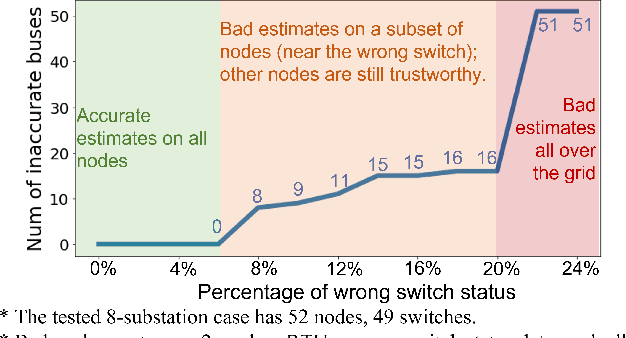
Abstract:An accurate and up-to-date grid topology is critical for situational awareness. However, it is non-trivial to obtain due to inaccurate switch status data caused by physical damage, communication error, or cyber-attack. This paper formulates a circuit-theoretic node-breaker (NB) model to create a generalized state estimation (GSE) method that is scalable and easily solvable for a practical grid with RTU and PMU measurements. We demonstrate that all switching devices (with discrete status) and meters (with continuous measurements) can be replaced with linear circuit models without relaxation so that the entire grid is mapped to an expanded linear circuit. Using this grid model, the state estimation is formulated as a Linear Programming (LP) problem whose solution includes a sparse vector of noise terms, which localizes suspicious wrong status and bad data separately. The proposed method provides the benefits of convexity and a reliable state estimation with intrinsic robustness against wrong switch status and bad measurement data.
Combined Transmission and Distribution State-Estimation for Future Electric Grids
May 14, 2021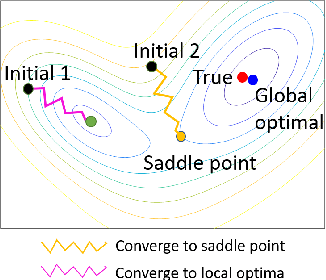
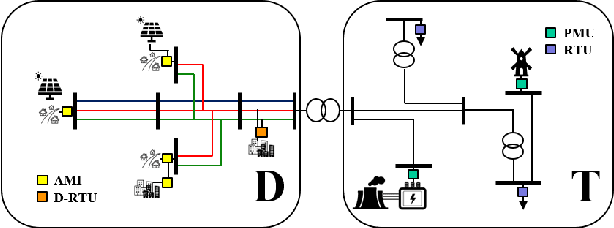
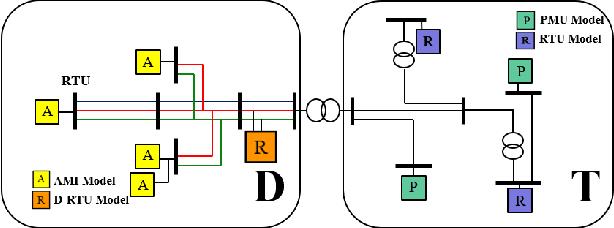
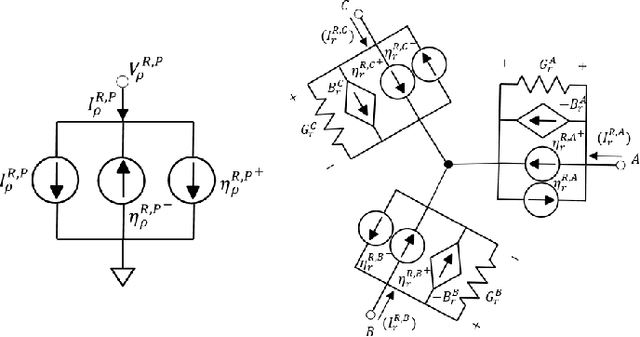
Abstract:Proliferation of grid resources on the distribution network along with the inability to forecast them accurately will render the existing methodology of grid operation and control untenable in the future. Instead, a more distributed yet coordinated approach for grid operation and control will emerge that models and analyzes the grid with a larger footprint and deeper hierarchy to unify control of disparate T&D grid resources under a common framework. Such approach will require AC state-estimation (ACSE) of joint T&D networks. Today, no practical method for realizing combined T&D ACSE exists. This paper addresses that gap from circuit-theoretic perspective through realizing a combined T&D ACSE solution methodology that is fast, convex and robust against bad-data. To address daunting challenges of problem size (million+ variables) and data-privacy, the approach is distributed both in memory and computing resources. To ensure timely convergence, the approach constructs a distributed circuit model for combined T&D networks and utilizes node-tearing techniques for efficient parallelism. To demonstrate the efficacy of the approach, combined T&D ACSE algorithm is run on large test networks that comprise of multiple T&D feeders. The results reflect the accuracy of the estimates in terms of root mean-square error and algorithm scalability in terms of wall-clock time.
Dynamic Graph-Based Anomaly Detection in the Electrical Grid
Jan 01, 2021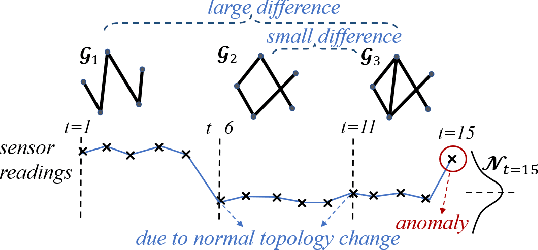
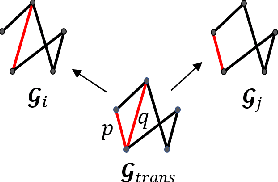
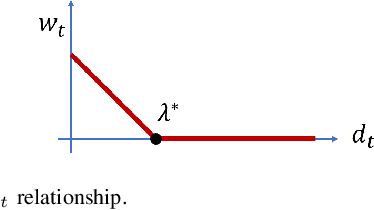
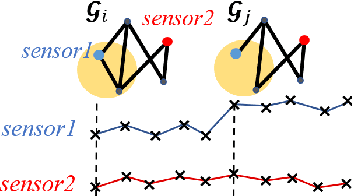
Abstract:Given sensor readings over time from a power grid, how can we accurately detect when an anomaly occurs? A key part of achieving this goal is to use the network of power grid sensors to quickly detect, in real-time, when any unusual events, whether natural faults or malicious, occur on the power grid. Existing bad-data detectors in the industry lack the sophistication to robustly detect broad types of anomalies, especially those due to emerging cyber-attacks, since they operate on a single measurement snapshot of the grid at a time. New ML methods are more widely applicable, but generally do not consider the impact of topology change on sensor measurements and thus cannot accommodate regular topology adjustments in historical data. Hence, we propose DYNWATCH, a domain knowledge based and topology-aware algorithm for anomaly detection using sensors placed on a dynamic grid. Our approach is accurate, outperforming existing approaches by 20% or more (F-measure) in experiments; and fast, running in less than 1.7ms on average per time tick per sensor on a 60K+ branch case using a laptop computer, and scaling linearly in the size of the graph.
 Add to Chrome
Add to Chrome Add to Firefox
Add to Firefox Add to Edge
Add to Edge